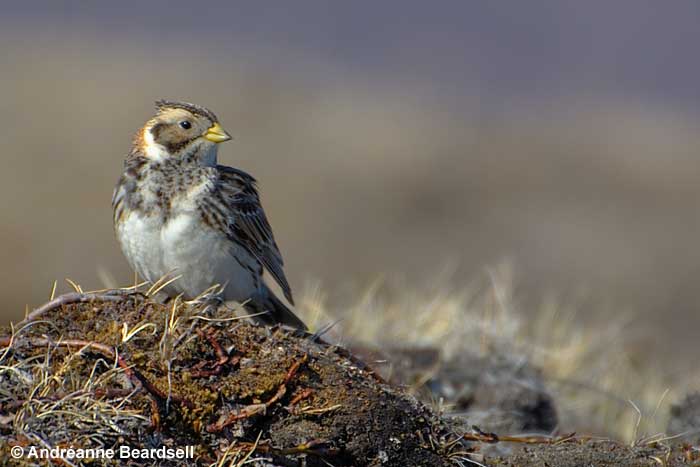As one of the most abundant and visible terrestrial bird breeding in the Arctic, the Lapland longspur is certainly the most common passerine nesting on Bylot Island. During the summer, it can be observed nesting on the tundra, between two hummocks (small mounds in the ground) or feeding on seeds and small insects. As other Arctic-nesting birds, Lapland longspurs are constrained by a very short time period during which they can reproduce. Summer is short in the Arctic and young need a certain time to grow enough to be ready for the fall migration. In these conditions, it has been noticed that earlier nesters have a better chance to successfully reproduce, i.e. have young and bring them to maturity.
Breeding ecology
Studying the breeding ecology of the longspurs can provide interesting insights on how Arctic-breeding songbirds adapted to their harsh breeding environment. For this reason, we monitor the nesting activities of Lapland longspur on Bylot Island since 1995. Over the years, egg-laying and egg-hatching dates vary, reflecting variations in the environmental conditions themselves. On average, the first egg is laid on 17 June (range: 8 to 23 June). The overall average clutch size of Lapland longspurs on Bylot Island is 5.4 eggs per nest (range: 4.8 to 6.0 eggs/nest). Females incubate eggs for only 12 days and eggs will hatch over a period of 1 to 4 days. Hatching date is usually around 2 July (range: 24 June to 10 July).
 |
 |
 |
 |
Though the timing of hatch is critical for the growth and survival of young, even more crucial is the ability of longspurs to ensure that their nests survive until hatch. Nest predation is an important source of mortality for this bird especially when lemming abundance is low. Longspurs eggs are an alternative prey resource for the arctic fox, which preys primarily on lemmings. Alternately, when lemmings are abundant, the arctic fox will focus on lemmings, and longspurs may experience reduced predation pressure and increased nesting success. Nesting success represents the proportion of all nests where at least one young fledged. On average, nesting success is 45% but this parameter varies considerably among years (minimum: 7%, maximum: 82%). It is interesting to note that longspurs had high nesting successes during the 2000, 2004, 2010, 2011 and 2014 lemming peaks.
The full dataset of our longspur nesting monitoring on Bylot Island is available on NordicanaD.
| Glaucous gull | Shorebirds |
